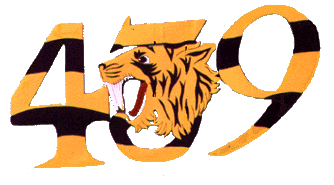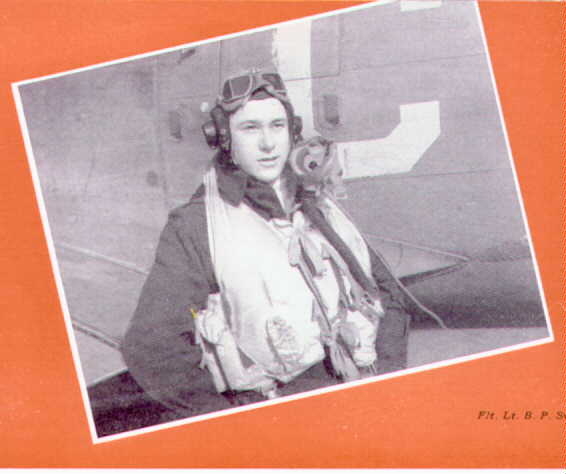|
History
of
 Squadron Squadron
  
Chapter
IV
The
Battle of Normandy
June
- August 1944
 F/O B.P. Swingler F/O B.P. Swingler
|
Cloud on the 25th was followed by
almost continuous rain on the 26th. The last of the ground
parties moved out for the "sausage
machine" (the concentration area for embarkation) and
late in the afternoon the long, and eagerly, awaited instructions for the
airlift party were received. The next morning (27 June) seventeen pilots
took off for the last time from Hurn and set course across the Channel to
Normandy. The Squadron's eighteenth Typhoon was flown by G/C (Group Captain
– equivalent to a Lieutenant Colonel in the Army) P.Y. Davoud, the Sector
C.O. Forty-five minutes later, at 10 a.m., they landed at Camilly (B.5),
where 121 Airfield was based. F/O "Babe" Swingler had some
tough luck when his Typhoon caught fire as he landed, destroying all
the clothing and personal equipment stowed on board. At midday the remaining
eight pilots, with the adjutant, medical officer and ground crews flew
across with the Dakota airlift to another airfield on the beach-head whence
trucks conveyed them through the mud and rain to B.9 at Lantheuil which had
been allotted to 143 Airfield. For the ground crews in particular it was a memorable
experience to see the incredible number of ships covering the surface of the
Channel and crammed against the beaches
|
The
runways at Lantheuil were not serviceable for the Typhoons because of
the heavy rainfall on the 26th, so they operated from other
landing-strips on the 28th. No. 439 got in three missions
from Camilly before landing at their own base in the evening. All
three were bridge attacks, two against the highway bridge across the
Orne at Amaye and the third against another structure at Thury-Harcourt.
The first attack was off the mark.
(At
the end of this sortie the four pilots led by F/L Fiset landed at B.9
at 1550 hrs, being the first of the Wing's aircraft to arrive there).
The second attack was much better with two direct hits and four near
misses; and the third scored a bull's-eye, ten direct hits that
destroyed the bridge. (No. 439 states that the third operation was
carried out (at 2030-2055) with No. 440, but the latter Squadron does
not report any
sorties for that period. It shows an attack on this bridge about six
hours earlier.) On one sortie S/L Norsworthy’s engine cut out while
he was over enemy territory. He
was able to glide about seven miles to the right side of the lines and
then made a belly-landing in an open field near Tilly.
He was picked up, uninjured, by a British medical unit
stationed close by, and after a cup of tea was sent "on
his way rejoicing" in the unit's "blood-wagon".
|

Church
service in the Field, Lantheuil, Aug 1944
Photo
source: 439 Sqn archives
|
While the pilots were working from other airfields, the
ground-crews at Lantheuil were busy with shovels, axes and knives,
clearing away the brush, laying out sleeping sites and erecting tents.
"Now
we know how the pioneers feel in virgin territory." Hedges and trees
provided natural camouflage for most of the tents, trucks, equipment and
fuel. Slit trenches were also excavated - and quickly put to use. One
night, shortly after arrival at B.9, some bombs landed not far away and,
as the
"Doc" dryly remarked, there was little need to
administer any laxatives.
  
|
|